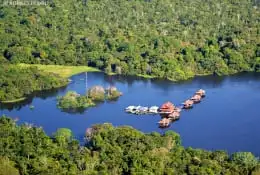MAMIRAUÁ UACARI LODGE
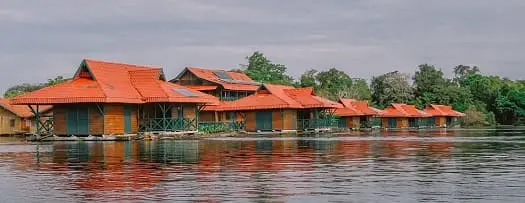


Mamirauá is also home to approximately 400 species of bird and at least 45 species of mammal. One of the strangest is the White Uacari Cacajao calvus. A monkey of four kilos feeds almost exclusively on the seeds of unripe fruits. Uacaris live in groups of up to 50 individuals, and travel many kilometers every day, in search of their favorite foods. Also endemic to Mamirauá is the Black Headed Squirrel Monkey Saimiri vanzolinii, and the lakes and rivers provide a refuge for the Amazon Manatee Trichechus inunguis and the Red River Dolphin Inia geoffrensis. Some of the most important tropical timber species are still found in the area protected by the RSDM. Scientific research is one of the principal activities within the Reserve producing and publishing various theses (Masters and Doctoral) and scientific articles about Mamirauá. This research was essential in the drawing-up of a Management Plan for the Reserve.
The local human population has not been relocated, and is instead involved in a participate process that aims to secure an improvement in their standard of living and their help in the management and protection of biodiversity within the RSDM. Local communities take a role in research, extension and management, occupying a strategic position in the decision-making process. A unique experience in Brazil when it began, this approach is beginning to be adopted in other conservation projects.
Rates
| 2025 | 3 Nights | 4 Nights | 7 Nights | |||
|---|---|---|---|---|---|---|
| VALID | *** OCTOBER->DECEMBER/2025 *** | |||||
| INDIVIDUAL | R$ 5.090 | R$ 5.790 | R$ 8.210 | |||
| DOUBLE/TRIPLE | R$ 4.848 | R$ 5.515 | R$ 7.816 | |||
| QUADRUPLE | R$ 4.610 | R$ 5.240 | R$ 7.420 | |||
| 2026 | 3 Nights | 4 Nights | 7 Nights | |||
| VALIDADE | *** JANUARY->MAY/2026 & OCTOBER->DECEMBER/2026 *** | |||||
| INDIVIDUAL | R$ 5.490 | R$ 6.240 | R$ 8.850 | |||
| DUPLO/TRIPLO | R$ 5.226 | R$ 5.945 | R$ 8.425 | |||
| QUÁDRUPLO | R$ 4.960 | R$ 5.650 | R$ 8.000 | |||
| VALIDADE | *** JUNE->SEPTEMBER/2026 *** | |||||
| INDIVIDUAL | R$ 5.090 | R$ 5.790 | R$ 8.210 | |||
| DUPLO/TRIPLO | R$ 4.848 | R$ 5.515 | R$ 7.816 | |||
| QUÁDRUPLO | R$ 4.610 | R$ 5.240 | R$ 7.420 | |||
| ATTENTION | PACKAGES DEPARTING FROM TEFÉ - Transfers according to Azul Flight (AIR-TICKETS NOT INCLUDED): 3 nights - Fridays to Mondays; 4 nights - Mondays to Fridays; and 7 nights: either Mondays or Fridays. | |||||
| SEASON | INDIVIDUAL | DOUBLE |
|---|---|---|
| 2025 | R$ 10.700 | R$ 9.660 |
| 2026 | R$ 11.320 | R$ 10.265 |
| PACKAGES DEPARTING FROM TEFÉ | ||
| JAGUAR EXPEDITION | INDIVIDUAL/DOUBLE |
|---|---|
| 2026 | WAITING FOR THE DATES |
| PACKAGES DEPARTING FROM TEFÉ | |
Additional Information
For safety reasons, only children over 10 years old will be accepted.
Pets are not allowed.
Packages including: Transportation (Tefé-Mamirauá Reserve-Tefé), accommodation, full board, water, juice, coffee and tea, excursions and bilingual guide (English speaking).
It does not include: Air pass Manaus-Tefé-Manaus, hotel and other expenses in Tefé, other expenses in Mamirauá (cooling and alcoholic drinks, handcrafts, books, etc...), any travel insurance, and anything else not mentioned as included.
Maximum luggage per person is 15 Kg. If necessary leave your extra luggage in Mamirauá office in Tefé.
Cancellation have to be request by e-mail to amazon@viverde.tur.br, and the cases will be analyzed and fee charged as following:
- More than 31 days BEFORE check-in, 25% of total OR 100% to be used in another reservation within 18 months.
- Between 30 AND 11 days from check-in, 30% of total OR 70% to be used in another reservation within 18 months.
- 10 days to 01 days, no reimbursement or 50% to be used in next reservation.
The Uacari
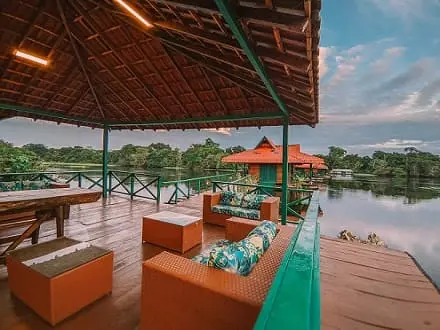
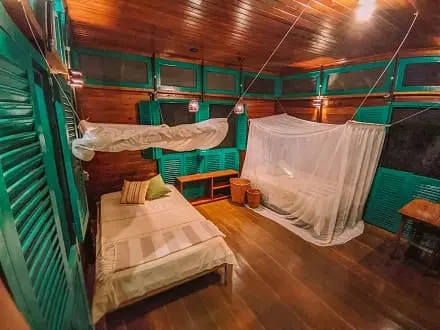
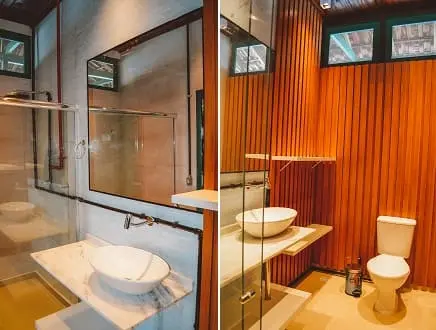
The Uacari lodge is cozy and comfortable, using alternative technologies like solar energy and an adequate sewage system for minimize the environmental impacts.
*NO AIR-CONDITIONING.
Mamirauá is also home to approximately 400 species of bird and at least 45 species of mammal. One of the strangest is the White Uacari Cacajao calvus. A monkey of four kilos feeds almost exclusively on the seeds of unripe fruits. Uacaris live in groups of up to 50 individuals, and
travel many kilometers every day, in search of their favorite foods. Also endemic to Mamirauá is the Black Headed Squirrel Monkey Saimiri vanzolinii, and the lakes and rivers provide a refuge for the Amazon
Manatee Trichechus inunguis and the Red River Dolphin Inia geoffrensis. Some of the most important tropical timber species are still found in the area protected by the RSDM. Scientific research is one of
the principal activities within the Reserve producing and publishing various theses (Masters and Doctoral) and scientific articles about Mamirauá. This research was essential in the drawing-up of a Management Plan for the
Reserve.
The local human population has not been relocated, and is instead involved in a participate process that aims to secure an improvement in their standard of living and their help in the management and protection of biodiversity within the RSDM. Local
communities take a role in research, extension and management, occupying a strategic position in the decision-making process. A unique experience in Brazil when it began, this approach is beginning to be adopted
in other conservation projects.
Accommodation
Mamirauá is the name of the reserve and the Institute that develop many projects in that area including ecotourism. The Uacari Floating lodge is destined for the ecotourism. The lodge has 10 simple, comfortable and ample apartments (25 square meters). Private bath equipped with hot shower,
solar energy for light and sewage filters. The rooms are connected by floating walkway to the Central floating House. There, guests find the restaurant, video room, library, deck. The restaurant offers a varied menu including regional meals.
The Uacari lodge is cozy and comfortable, using alternative technologies like solar energy and an adequate sewage system for minimize the environmental impacts.
Transfers
Manaus-Tefé- There are two ways to reach Tefé from Manaus:
> AERIAL: AZUL Linhas Aéreas - Remember that regular transfers are for Azul flights.
> FLUVIAL in regional boats navigating 40 hours or speed boats for 18 hours by Amazonas River.
For further information and tickets sale contact harbor administration in Manaus or Tefé.
We are not responsible for flight or boat delay or cancellation.
In Tefé, the hotels recommended for overnight: Pousada Multicultura. The air-passes, boat tickets and hotel in Tefé are not included in the Uacari package rate, but you can book it with Viverde.
Tefé-Mamirauá(FLUVIAL) - it is included in the rate:
2 hours scenic trip in big and comfortable motorized canoe accompanied by the local guide. Navigating first by Tefé Lake, where it is possible to see the dolphins and then Solimőes (Amazonas) river, where you can see
tucuxis. This part of the trip to the Reserve is only possible during the day for safety reasons.
Tips and suggestions
Bring in the luggage:
- Comfortable long pants, long sleeve shirts, rubber boots, comfortable shoes or tennis, cap or hat, repellent for insects, rain gear, sun lotion, flashlights, camera and binoculars.
* In the case of being allergic, do not forget to bring the personal medicine.
**Repellent and rain gear are necessary during all year, but January and February are characteristics of the great incidence of mosquitoes and rain.
Mamirauá Sustainable Development Reserve
The Governor of the state of Amazonas created the Mamirauá Sustainable Development Reserve (RSDM) in 1990 as an Ecological Reservation. In 1996, with the completion of the Management Plan, the state government changed its status to that of a Sustainable Development Reserve. The Reserve’s objective is the protection of the várzea at the confluence of the Solimőes and Japurá rivers near the town of Tefé.
Várzea is forest flooded every year by rivers rich in sediments and nutrients, and it may remain under water for more than four months each year. The turbid waters transport a huge load of sediments, which are deposited during the floods, making the soils of the várzea productive and fertile compared to those elsewhere in Amazon region. With a total area of 1,124,000 hectares (almost a third of the size of Belgium), up to 80km of forest can be submerged between the courses of these two important Amazonian rivers.
Each year, the water levels can rise by up to 12 meters. The animals and plants of Mamirauá must adapt for survival in the extreme conditions of this environment. Many trees are entirely submerged. For this reason, the várzea animals are either tree dwellers or good swimmers!
During the high water season, fish invade the flooded forest and take on the role of seed dispersal, which in other forests belongs to quatis, squirrels and other terrestrial mammals – absent from Mamirauá – as well as various bird species. The annual flood transforms the life of the whole region. Many animals depend on the fruits and seeds produced by the trees during the floods. Some, such as the Tambaqui Colossoma Macroponum, feed of fruits that fall into the water. More than 300 species of fish have already been catalogued in the reserve, including several ornamentals, such as the Discus Synphysodon Aequifasciatus.
Conduct in the Reserve:
- It is not allowed to remove any kind of materials (plants, animals, eggs, etc.)- It is not allowed to throw trash (for this you it will find garbage collectors in the floating house).
- Alcoholic drinks are only allowed in the floating house and not during the excursions.
- Do not take bath in the rivers, igapós, creeks, lakes, etc. (because of the presence of piranha fish and caimans that live in the waters of the Reserve).
- It is not allowed to go on expeditions without assistance of the guides.
Conduct on the trails:
- Do not to touch in the shrubs, trees, etc., it could be bad surprise the presence of animals' type: scorpion, ant and poisoned spiders, among other small animals, which will be able to cause disagreeable accidents.
- So, in order that you can enjoy the beauty of the animals in the tracks, is necessary total silence, using discrete colors clothes and do not take utensils that produce racket.
NOTE: The not fulfillment of these orientations can cause serious accidents, whose responsibility is exclusively of the guest.
Recommendations about the village visits:
1. How does the local population benefit? All workforce used by the ecotourism program in the Reserve is locally resident. The locals participate in ecotourism activities rendering services as guides and kitchen staff, selling agricultural produce, fish and art craft.
2. Where are the villages located? When you visit the Mamirauá Sustainable Development Reserve, you will have the opportunity to visit a village located nearby the floating house where you will be staying. There are four villages inside the area destined to the development of the ecotourism program; together they constitute the
Mamirauá Sector.
3. Why visit the villages? The idea to offer an opportunity to interact with the local population was born in two ways. On one hand the visitors showed a growing interest in having some contact with the local population, as well as seeing the impacts of the Mamirauá Project on the communities. On the other side, the residents also wished to have contact with the tourists, understanding they would benefit from cultural exchange
and selling of products.
4. Locally-made handicrafts: The main marketable product offered to the tourists is handicraft. The production of handicrafts represents more than an economic activity, it is the result of a cultural activity produced mainly by
women. The sale of handicrafts provides households with an additional source of income.
5. Different cultures: The population of the villages is not Indian. They are called ribeirinhos, or 'river
people', a mix of Amerindian and European peoples. Their culture is very different from the urban one, and it is
necessary to pay attention to those differences.
6. There are many advantages that can come from the interaction between the ecotourist and the locals;
however, there is a series of observations that have to be borne in mind in order to avoid possible negative
social impact from these visits:
- Respect the privacy of local inhabitants in their residencies.
- Always ask permission before taking photos or filming something or someone that you find interesting.
- Avoid taking pictures of children. It is not enough to have their permission; you need to ask their parents' permission as well.
There are no pre-determined rules; we believe that common sense can guide the tourist during the visit. In this way we will be avoiding possible negative social impacts as a result of the interaction of such different cultures.
In case you come across situations where you have doubts or questions, always ask the person responsible for the visit.
Ecotourism
PICK-UP AT TEFÉ AIRPORT
Optional: Jungle Tree House (extra payment at the lodge), if available.
4 days and 3 nights package
1st day
Pick-up at Tefé Airport OR Hotel. Transfer from Tefé to Uacari Lodge. Check-in at Uacari Lodge, interpretative trail (or boat ride during the wet season). Dinner and short presentation about Mamirauá Sustainable Development Reserve, Mamirauá Sustainable Development Institute, the Community-Based Program and Uacari Lodge objectives and results.
2nd. day
Community visit in the morning. Lunch and resting time till 03:00PM. Hike (dry season) or traditional canoe ride (wet season) in the afternoon. Dinner. Presentation of the Pink River Dolphin OR Jaguar Research Program at night.
3rd. day
Hike (dry season) or traditional canoe ride (wet season) in the morning. Lunch and resting time till 03:00PM. In the afternoon and early evening visit to Mamirauá Lake, night-spotting caimans when the night falls, on the way back to the Lodge. Dinner, free night.
4th. day
Traditional canoe tour after breakfast. Check-out and transfer to Tefé.
5 days and 4 nights package
1st day
Pick-up at Tefé Airport OR Hotel. Transfer from Tefé to Uacari Lodge. Check-in at Uacari Lodge, interpretative trail (or boat ride during the wet season). Dinner and short presentation about Mamirauá Sustainable Development Reserve, Mamirauá Sustainable Development Institute, the Community-Based Program and Uacari Lodge objectives and results.
2nd. day
Community visit in the morning. Lunch and free time until 03:00PM. Hike (dry season) or traditional canoe ride (wet season) in the afternoon. Dinner. Night trail, (dry season) or night boat tour (wet season). Night trail, (dry season) or night boat tour (wet season).
3rd. day
Hike (dry season) or traditional canoe ride (wet season) in the morning. Hike (dry season) or traditional canoe ride (wet season) in the morning. Lunch and free time until 03:00PM. In the afternoon and early evening visit to Mamirauá Lake with a boat picnic and sunset. Night-spotting caimans when the night falls, on the way back to the Lodge. Dinner. Free night.
4th. day
Traditional piranha fishing in the morning. Lunch and free time until 03:00PM. In the afternoon hike (dry season) or traditional canoe tour (wet season). Presentation of the Pink River Dolphin OR Jaguar Research Program at night.
5th. day
Traditional canoe tour after breakfast. Check-out and transfer to Tefé.
8 days and 7 nights package
The visitor will have a night at the Jungle Tree House - to be scheduled at the Lodge, according to availability and weather conditions.
1st day
Pick-up at Tefé Airport OR Hotel. Transfer from Tefé to Uacari Lodge. Check-in at Uacari Lodge, interpretative trail (or boat ride during the wet season). Dinner and short presentation about Mamirauá Sustainable Development Reserve, Mamirauá Sustainable Development Institute, the Community-Based Program and Uacari Lodge objectives and results.
2nd. day
Community visit in the morning. Lunch and free time until 03:00PM. Hike (dry season) or traditional canoe ride (wet season) in the afternoon. Dinner. Night trail, (dry season) or night boat tour (wet season).
3rd. day
Hike (dry season) or traditional canoe ride (wet season) in the morning. Hike (dry season) or traditional canoe ride (wet season) in the morning. Lunch and free time until 03:00PM. In the afternoon and early evening visit to Mamirauá Lake with a boat picnic and sunset. Night-spotting caimans when the night falls, on the way back to the Lodge. Dinner. Free night.
4th. day
Traditional piranha fishing in the morning. Lunch and free time until 03:00PM. In the afternoon hike (dry season) or traditional canoe tour (wet season). Presentation of the Pink River Dolphin OR Jaguar Research Program at night.
5th. day
Departure from Uakari Lodge at 05:30AM for the sunrise in the area where Japurá and Solimőes River meet. This place is a great spot for pink and grey river dolphins. Breakfast at the lodge at 08:00AM. Boat trip at 09:00hs. Lunch and free time until 03:00PM. Interpretative trail or another of tourist´s choice. Dinner and free night. Free night.
6th. day
Visit to a different community in the morning OR hike/canoe tour. Lunch and free time until 03:00PM. During the afternoon a boat trip to JapuráRiver, a great spot for dolphins and sunset. Dinner. Free night.
7th. day
Hike (dry season) or traditional canoe ride (wet season) in the morning. Lunch and free time until 03:00PM. Boat tour in the afternoon. Dinner. Free night.
8th. day
Traditional canoe tour after breakfast. Check-out and transfer to Tefé.
ATTENTION:
> The activities described above can be changed due to environmental factors, water level variation and climate conditions.
> During the flood (May-July) all trails will be done in a small paddle canoe (your guide will paddle you through the trail).
> The local guides don’t speak English fluently.
BIRD WATCHING TOURS
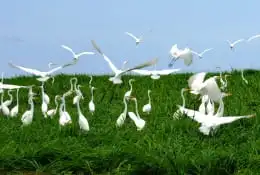
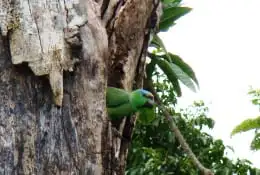
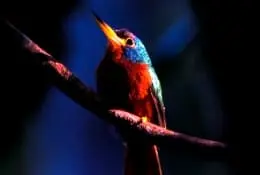
Total Immersion for Bird Enthusiasts
The Amazon is one of the top destinations for birdwatchers from all over the world. With a huge number of endemic species, it gets as fantastic as nowhere else on this planet.
But few areas in the Amazon can offer the possibility of joining both the comfort of a peaceful floating hotel of forest and the contact with researchers and specialized guides, who can provide all the information a birdwatcher needs.
The unique characteristic of Mamirauá Sustainable Development Reserve, a UNESCO World Natural Heritage site of floodplain forest, makes it an intriguing place for spotting birds that are typical of this kind of environment. There are some species, for example, that can only be seen on the Amazon River islands.
Why choose this experience?
When coming to this adventure you can:
- Marvel at the Hoatzin (Opisthocomus hoazin): an extraordinary bird with awkward movements, a stylish crest and reminding a ruminant - it can digest leaves thanks to bacteria within its digestive system.
- Observe again and again the Wattled curassow (Crax globulosa): native to lowland rainforest it can be sighted high up in the trees and reaches 82cm (32") in length.
- Put your binoculars to the test on the tiny Black-bellied Thorntail (Discosura langsdorffi), one of the smallest hummingbirds in Brazil and one which is threatened with extinction.
- Dream of an encounter with the Harpy Eagle (Harpia harpyja), the most powerful bird of prey in the world and one of the largest.
- Have fun with the jumping jacks on the forest floor - like the rare Zigzag Heron (Zebrilus undulatus).
- Besides getting to see many of the 362 species of birds Mamirauá Reserve has!
In the wet or in the dry?
Opportunities for birdwatchers vary according to the season
In the wet season (May to July) the best sightings are made from canoes. With trails flooded to the height of the treetops, the birds are much closer, whether perched or in flight. During the dry season (August to April) the birds that feed on fish, such as the Herons (Ardeidae) and Cormorants (Phalacrocorax brasilianus) can be seen in huge numbers. The giant flocks of them are breathtaking.
Bird Watching Program - 04 nights
The visitor will be received at Tefé Airport (Azul Airlines) and will be transferred to the port, where a boat will be prepared to take the group to Uacari Lodge. After traveling the mighty Solimőes, which is how this stretch of the Amazon River is called in Brazil, for about one hour, we will get into one channel of Mamirauá Lake. During the way we might already see bird's species such as the Yellow-hooded Blackbird (Agelaius icterocephalus) and Oriole Blackbirds (Gymnomystax mexicanus), Velvet-fronted Grackle (Lampropsar tanagrinus) and aquatic mammals such as Amazon (Pink) River Dolphin (Inia geoffrensis) and Grey River Dolphin (Sotolia fluviatilis).
As the environment of Mamirauá changes a lot along the year due to the flood seasons, the programs are also adapted so the tourist can get the best of their visit. Please find bellow the itineraries for the dry and wet seasons!
Itinerary Description - Dry season (August - April)*
1st. Day
After check-in in the lodge, we will be exploring the surroundings on a small motor boat. Some of the birds we might see this afternoon include Short-tailed (Graydidascalus brachyurus) and Festive Parrots (Amazona festiva), White-chinned (Galbula tombacea) and Paradise Jacamars (Galbula dea), and many more.
2nd. Day
We will have one first tour to observe birds in the earlier hours of the day (birds are highly activity during this time).
After breakfast, we will be walking the first trail in the Várzea forest to look for some of the highlights here, like the Scarlet-crowned Barbet (Capito aurovirens), White-throated
Toucan (Ramphastos tucanus), Black-crested Antshrike (Sakesphorus canadensis) and the rare Wattled Curassow (Crax globulosa). In this trail you can find the amazing Sloths (Bradypus
variegatus), Red Howler Monkeys (Alouatta seniculus) and Uakari Monkeys (Cacajao calvus calvus).
In the afternoon we will be walking another trail through the Várzea forest, on the
look for several species such as Long-billed (Nasica longirostris) and Zimmer's Woodcreepers (Dendroplex kienerii), White-chinned Jacamar (Galbula tombacea) and,
with some luck, the elusive Zigzag Heron (Zebrilus undulates).
After dinner, we might go out on the canoe in search of night birds.
3rd. Day
We will have one first tour to observe birds earlier. This morning we will be heading again to the Várzea forest. We might have a chance for a photograph or a better look at birds that
we have seen before, or still be looking for new birds such as the Razor-billed Curassow (Pauxi tuberose), Chestnut-capped Puffbird (Bucco macrodactylus), Slate-colored Hawk (Buteogallus schistaceus),
Plumbeous Antbird (Myrmeciza hyperythra), and more. In the afternoon we will be heading our boat to the Mamirauá Lake and, as we cruise in our boat towards the lake, we will be on the look for the Uakari Monkey
(Cacajao calvus calvus), Black Caimans (Melanosuchus niger), Horned Screamer (Anhima cornuta), Hoatzin (Opistocomus hoazin), Tui Parakeet (Brotogeris sanctithomae) and Spot-breasted Woodpecker (Colaptes punctigula).
It will be dark when we head back to the lodge, and there might be a chance for night birds such as Great Potoo (Nyctibius grandis) and Tawny-belied (Megascops watsonii) and Black-banded Owls (Strix huhula).
4th. Day
We will have one first tour to observe birds earlier. Today our morning will be dedicated to birding the river edge of the Solimőes River, especially the islands of the river, in search of species that only live in this particular habitat.
Among them are Parker's (Cranioleuca vulpecula), Red-and-white (Certhiaxis mustelinus) and White-bellied Spinetail (Synallaxis propinqua), Lesser Hornero (Furnarius minor) and the Black-and-white Antbird (Myrmochanes hemileucus), and the grassy areas on the edge of the water could provide Wing-barred (Sporophila americana),
Chestnut-bellied (Sporophila castaneiventris) and Lesson's Seedeaters (Sporophila bouvronides).
The afternoon will be dedicated to explore one more trail, close to the lodge.
5th. Day
This is our last morning and we still have time for a short outing before breakfast. After breakfast we will check-out the lodge and transfer back to Tefé, in order to be at the airport in time to catch our flight back to Manaus.
Itinerary Description - Flood Season (May - July)*
1st. Day
After check-in in the lodge, we will be exploring the surroundings on a small motor boat. Some of the birds we might see this afternoon include Short-tailed (Graydidascalus brachyurus) and Festive Parrots (Amazona festiva), White-chinned (Galbula tombacea) and Paradise Jacamars (Galbula dea), and many more.
2nd. Day
We will have one first tour to observe birds in the earlier hours of the day (birds are highly activity during this time). After breakfast, boat to the Apara channel. This is a very birdy area and some of the highlights
here are the Hoatzin (Opisthocomus hoazin), Scarlet-crowned Barbet (Capito aurovirens), White-eared Jacamar (Galbalcyrhynchus leucotis), Black-crested Antshrike (Sakesphorus canadensis) and the rare Wattled Curassow (Crax globulosa).
This is also a good place to find Sloths (Bradypus variegatus), Red Howler Monkeys (Alouatta seniculus) and Uakari Monkeys (Cacajao calvus calvus).
In the afternoon we will be canoeing through the Várzea (flooded) forest, on the look for several species such as Long-billed (Nasica longirostris) and Zimmer's Woodcreepers (Dendroplex kienerii), White-chinned Jacamar (Galbula tombacea)
and, with some luck, the elusive Zigzag Heron (Zebrilus undulates).
After dinner, we might go out on the canoes in search of night birds.
3rd. Day
We will have one first tour to observe birds earlier. This morning we will be heading again to the flooded forest, this time in a different area. We might have a chance for a photograph or a better look at birds that we
have seen before, or still be looking for new birds such as the Razor-billed Curassow (Pauxi tuberose), Chestnut-capped Puffbird (Bucco macrodactylus), Slate-colored Hawk (Buteogallus schistaceus), Plumbeous
Antbird (Myrmeciza hyperythra), and more. In the afternoon we will be heading our boat to the Mamirauá Lake and, as we cruise in our boat towards the lake,
we will be on the look for the Uakari Monkey (Cacajao calvus calvus), Black Caimans (Melanosuchus niger), Horned Screamer (Anhima cornuta), Hoatzin (Opistocomus
hoazin), Tui Parakeet (Brotogeris sanctithomae) and Spot-breasted Woodpecker (Colaptes punctigula).
It will be dark when we head back to the lodge, and
there might be a chance for night birds such as Great Potoo (Nyctibius grandis) and Tawny-belied (Megascops watsonii) and Black-banded Owls (Strix huhula).
4th. Day
We will have one first tour to observe birds earlier. If the water level is not too high, our morning will be dedicated to birding the river edge of the Solimőes River, especially
the islands of the river, in search of species that only live in this particular habitat. Among them are Parker's (Cranioleuca vulpecula), Red-and-white (Certhiaxis mustelinus) and
White-bellied Spinetail (Synallaxis propinqua), Lesser Hornero (Furnarius minor) and the Black-and-white Antbird (Myrmochanes hemileucus), and the grassy areas on the edge of the water
could provide Wing-barred (Sporophila americana), Chestnut-bellied (Sporophila castaneiventris) and Lesson's Seedeaters (Sporophila bouvronides).
The afternoon will be dedicated to explore another trail close to the lodge, by canoe.
5th. Day
This is our last morning and we still have time for a short outing before breakfast. After breakfast we will check-out the lodge and transfer back to Tefé, in order to be at the airport in time to catch our flight back to Manaus.
*Schedules can be changed according to weather conditions.
Most likely species to spot in Dry Season (August - April)
Boat tour: Crax globulosa, Porphyrio Martinica (most from January to April), Amazona festiva;
Night-spotting: Nyctibius grandis, Nyctibius griseus, Tyto alba;
Trails: Crax globulosa, Zebrilus undulatus, Galbula tombacea, Capito aurovirens, Ramphastos tucanus, Ramphastos vitellinus, Picumnus lafresnayi, Nasica longirostris, Sakesphorus
canadensis, Dendroplex kienerii, Schiffornis major.
Canoe tour in shores: Crax globulosa, Amazona festiva, Ramphastos tucanus, Ramphastos vitellinus, Gymnoderus foetidus.
Island trails: Cephalopterus ornatus, Myrmochanes hemileucus, Furnarius minor (easily seen at Caburini Community), Certhiaxis mustelinus, Cranioleuca vulpecula.
Mamirauá Lake: Anhima cornuta, Agamia agami, Amazona festiva, Opistochomus hoazin, Gymnoderus foetidus, Certhiaxis mustelinus, Cranioleuca vulpecula.
Night-spotting after lake visit: Cochlearius cochlearius, Hydropsalis leucopyga, Hydropsalis climacocerca, Nyctibius grandis, Nyctibius griseus, Tyto alba.
Night trail: In this activity it is more likely spot insects and spiders. It is rare spot birds.
Other animals of this time of the year: jacarés-açu and jacaré-tinga.
Most likely species to spot in Flooding Season (May - July)
Apara boat tour: Crax globulosa, Amazona festiva, Opistochomus hoazin, Galbacyrhynchus leucotis, Ramphastos tucanus, Ramphastos vitellinus, Gymnoderus foetidus and Sakesphorus canadensis.
Boat tour: Ara macao, Porphyrio Martinica, Amazona festiva, Capito aurovirens, Ramphastos tucanus, Ramphastos vitellinus and Gymnoderus foetidus.
Canoe in floodplain forest: Galbula tombacea, Capito aurovirens, Ramphastos tucanus, Ramphastos vitellinus and Nasica longirostris.
Mamirauá Lake: Anhima cornuta, Amazona festiva, Opistochomus hoazin, Gymnoderus foetidus, Certhiaxis mustelinus and Cranioleuca vulpecula.
Night-spotting after lake visit: Hydropsalis leucopyga, Hydropsalis climacocerca, Nyctibius grandis, Nyctibius griseus and Tyto alba.
Rare species: Harpia harpyja, Pteroglossus azara, Picumnus lafresnayi, Myrmotherula assimilis and Pipra filicauda.
Other attractions:
- the White Uacari monkey is easier observed, specialy during the canoe rides inside the forest.
- the sloth is observed more frequently between February to May.
Wildlife and scenery of the Amazon from all the right angles.
Mamirauá Sustainable Development Reserve is the ideal place to live the real Amazon, with no cliches. Here, you can easily meet rare animals in exuberant landscapes, followed by the great guides of the forest who are used to the area like no one else is. Put your camera into test and go back home with personal discoveries, beautiful pictures of endemic species of animals, documents of the riverside life and, beyond all that, with the certainty that your visit contributed to the efforts for the conservation of one of the greatest forest on Earth.
The Photo Journeys - 4 nights package
> Superior lodge accommodation.
> Private boat for day trips.
> Individual guide trained to assist photographers.
> Complete board: including special snacks on all outings & one bottle of wine per night.
Why choose this Experience?
The beauties of Amazon Forest and particularities which flood plains of Mamirauá can offer, allied to the comfortable stay at floating Pousada Uacari.
A little of what is waiting for you:
- To capture the different poses of the photogenic sloth.
- To invent a way of making a whole samaúma, giant kapok tree (one of the largest trees in the Amazon) fit in the one picture.
- For macrophotography: the bark of trees, twisted vines, the details in the huge water lilies, flowers, leaves, spider webs...
- To document everyday life by the river: the production of flour, the work in the fields, the fishing, the children at play and the houses on stilts.
- To delve into the images of the night, especially in the dry season: the starry skies, the movement of clouds and the forest in the darkness.
- To have an excuse to return the following year and to capture unique images of a different season. In the dry, huge alligators or unbelievable flocks of herons and cormorants in the late afternoon. In the wet, surreal reflections of flooded forest lakes.
One of the main features of the photography expedition is the exclusivity: the visitor will have a private boat and an individual guide trained to assist photographers, to go on tours anytime, anywhere in the ecotourism zone of Mamirauá Reserve. With a list of suggestions of activities - to be visited in the appropriate times for best lights - the photographer will make its own program according to his/her expectations.
Among the suggested activities, some fun challenges like...
- Get a good shot of the red-faced white Uakari monkey: this primate, the symbol of the reserve and endemic to Mamirauá, is very shy and moves quickly through the treetops.
- Be quick enough to capture the arapaima in the air: this fish that can measure up to 03 meters (118") and 200 kilos (440lb) jumps out of the water to breathe using its modified swim bladder.
- Overcome the vagaries of the light: this close to the Equator, the sun rises and sets very quickly, animals are often seen in backlight in the treetops and the dense forest filters the sunlight.
JAGUAR EXPEDITION
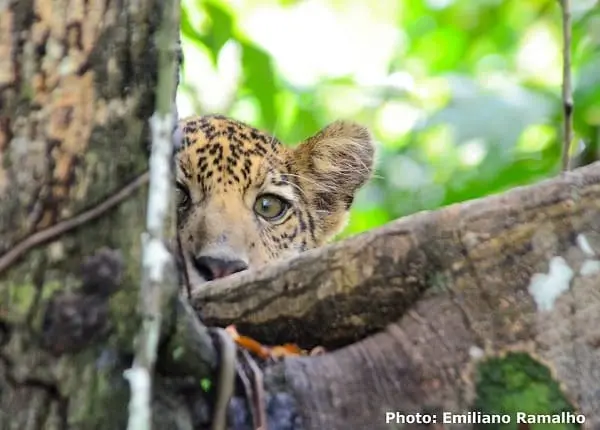
Take part in a scientific expedition with the Jaguars of the Amazon.
First package of this kind in the Amazon, on this expedition, visitors can look for jaguars (Panthera onca) in the Mamirauá Sustainable Development Reserve (MSDR) floodplain forest, permanently in the company of researchers from the Iauaretę Project / Mamirauá Institute for Sustainable Development. Some animals have GPS collars, as part of the research, making it possible for them to be monitored by visitors and researchers. It's important to remember that all animals are freely living in a Reserve area, however, spotting chances are very high, but not guaranteed since we do not feed animals for sightings.
The Jaguar Expedition is a pioneer initiative that aims for a new conservation model, financially sustainable and replicable, able to provide benefits to local communities through science-touristic activities as well as contributing to the jaguar population tracking in Mamirauá floodplain given that the more information is acquired, the easier it is to create strategies to preserve this species. The package price includes a direct donation to the Iauaretę Project, which is used to finance research and educational projects for local communities.
Uacari Lodge offers the opportunity to join the comfort of a floating lodge totally integrated to the landscape with a special team of researchers and guides. Visitors will work with them, understanding their work better. This experience is a deep dive in the jaguar´s ecology and in its dynamic in the Floodplain Forest.
Uacari Lodge is in Mamirauá Sustainable Development Reserve in the Middle Solimőes region. It's about 60 km from town of Tefé (about an hour and twenty minutes by boat). Tefé is the point of departure for the Lodge. There are one-hour flights every day to Tefé from Manaus, the capital of the state of Amazonas.
With 5 bungalows split in 10 rooms (Two bedrooms and two bathrooms each) with capacity of 20 guests. The lodge also has a central floating area with a small deck, restaurant, bar, video room and library. The facilities are ecologically sustainable. The energy comes from the sun, the rain is collected, the effluents are treated before going back tothe river, and the tiles are ecological, made of recycled PET from plastic bottles.
Why choose this experience?
- Mamirauá has one of the highest densities of jaguars in the world.
- Mamirauá Jaguars spend three months sleeping and hunting in the treetops, an amazing adaptation to the flooding of the forest. The only records of jaguars exhibiting this behavior are to be found in Mamirauá.
- A small and privileged group of tourists will have the chance to join The Jaguar Expedition. Each trip allows just four visitors, who will closely monitor the work of the researchers of the Iauaretę project. The goal is to find jaguars, the third largest feline in the world.
Challenges of the expedition
- Spot a black jaguar. Since monitoring began, this rare animal has been captured only once in Mamirauá.
- Spot a jaguar family. The jaguar has up to four offspring per pregnancy. The young accompany their mother for an average of two years.
- See a jaguar capturing its next meal. Jaguars usually sleep during the day and become more active at night. However, in places with a high density of animals, there is a chance of seeing them hunting during the day.
The expeditions will take place from May to July in specifics dates.
The Jaguar Expedition - 4 nights package
Visitors will be received at Tefé Airport. If chosen by the visitor, it is possible to fly over Mamirauá Reserve (optional service, directly hired by the visitor himself), track the jaguar's GPS signal and appreciate the beautiful Reserve overview in the company of Iauaretę Project researchers.
After that, visitors will be transferred to the port, where a boat will be prepared to take the group to the Uacari Lodge.After an one-hour traveling through the mighty Solimőes, which is how this stretch of the Amazon River is called in Brazil, visitors will get into one channel of the Mamirauá Lake. Along the way it might be
already possible to see aquatic mammals such as the Amazon (Pink) River Dolphin (Inia geoffrensis) and the Grey River Dolphin (Sotolia fluviatilis).
Day by day description
1st. Day
After check-in, visitors will have a small presentation about the MSDR, the Uacari Lodge and the Iauaretę Project, providing them with an opportunity to have a better understanding of the unique Mamirauá floodplain characteristics, learn about the lodge's and the project's activities in addition to their schedule for the next few days. Then, there is still time for a small paddle canoe tour to explore the Uacari Lodge surroundings, leaving the group with a free night after dinner.
2nd. Day
After breakfast the group will go on a field trip to look for jaguars with GPS collars. The location of each animal will be previously tracked by researchers, who will have access to the GPS points. The researcher will lead the work in a separately canoe with a VHF receptor. A safety distance will be asked and expected to be respected. The goal is to contemplate the biggest American feline, take photos, contribute to the research and learn about the jaguars. During the afternoon visitors will be involved in regular research activities, for instance inspecting camera-traps installed on the treetops. The goal is to capture animal images or animal signs, such as leftovers and other animal carcasses. After dinner the documentary "The Trapper" will be screened.
3rd. Day
Once again the group will go on a field trip to look for jaguars.In the afternoon while heading the boat to the Mamirauá Lake and cruising towards the lake, visitors will be on the lookout for the Uacari Monkey (Cacajao calvus calvus), Black Caimans (Melanosuchus niger), Horned Screamer (Anhima cornuta), Hoatzin (Opistocomus hoazin), Tui Parakeet (Brotogeris sanctithomae) and Spot-breasted Woodpecker (Colaptes punctigula). It will be dark when we head back to the lodge, and there might be a chance of night animals sighting.
4th. Day
In the morning groups will visit one of four communities: Boca do Mamirauá, Caburini, Sítio Săo José e Vila Alencar which regularly receives Uacari Lodge visitors. During the afternoon a sloth (Bradypus variegatus) - one of the main food supplies for jaguars - census will be made in trails near Mamirauá Lake and some camera-traps will be collected. After dinner the images from the camera-traps will be revealed and discussed.
5th. Day
This is the last morning and there is still time for a short outing after breakfast. Visitors will check-out from the lodge and be transferred back to Tefé, in order to be at the airport on time to catch the flight back to Manaus.
*Schedules can be changed according to the weather conditions.


